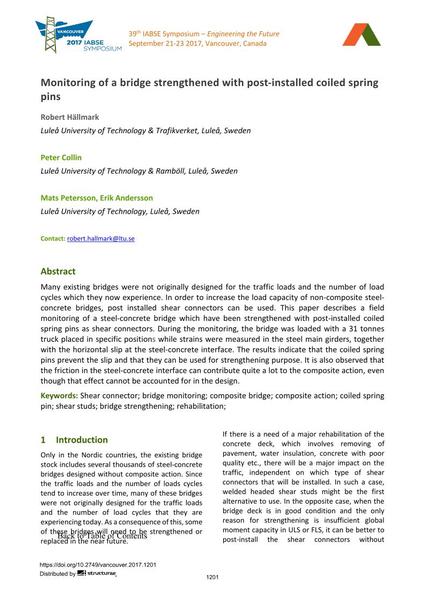Monitoring of a bridge strengthened with post-installed coiled spring pins

|
|
|||||||||||
Bibliografische Angaben
| Autor(en): |
Robert Hällmark
Peter Collin (Luleå University of Technology & Ramböll, Luleå, Sweden) Mats Petersson (Luleå University of Technology, Luleå, Sweden) Erik Andersson (Luleå University of Technology, Luleå, Sweden) |
||||
|---|---|---|---|---|---|
| Medium: | Tagungsbeitrag | ||||
| Sprache(n): | Englisch | ||||
| Tagung: | IABSE Symposium: Engineering the Future, Vancouver, Canada, 21-23 September 2017 | ||||
| Veröffentlicht in: | IABSE Symposium Vancouver 2017 | ||||
|
|||||
| Seite(n): | 1201-1208 | ||||
| Anzahl der Seiten (im PDF): | 8 | ||||
| Jahr: | 2017 | ||||
| DOI: | 10.2749/vancouver.2017.1201 | ||||
| Abstrakt: |
Many existing bridges were not originally designed for the traffic loads and the number of load cycles which they now experience. In order to increase the load capacity of non-composite steel- concrete bridges, post installed shear connectors can be used. This paper describes a field monitoring of a steel-concrete bridge which have been strengthened with post-installed coiled spring pins as shear connectors. During the monitoring, the bridge was loaded with a 31 tonnes truck placed in specific positions while strains were measured in the steel main girders, together with the horizontal slip at the steel-concrete interface. The results indicate that the coiled spring pins prevent the slip and that they can be used for strengthening purpose. It is also observed that the friction in the steel-concrete interface can contribute quite a lot to the composite action, even though that effect cannot be accounted for in the design. |
||||
| Stichwörter: |
Verbundbrücke Instandsetzung Brückenertüchtigung Brückenmonitoring
|
||||
